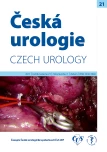-
Medical journals
- Career
EXTRACORPOREAL SHOCK WAVE LITHOTRIPSY: INITIAL EXPERIENCE WITH THE SIEMENS ELECTROMAGNETIC LITHOTRIPTER
Authors: Marek Broul 1; Jan Schraml 1; Miroslav Štrbavý 1; Petr Skála 1; Josef Liehne 2
Authors‘ workplace: Klinika urologie a robotické chirurgie Masarykovy nemocnice v Ústí nad Labem Krajská zdravotní, a. s. 1; Oddělení jednodenní chirurgie Masarykovy nemocnice v Ústí nad Labem Krajská zdravotní, a. s. 2
Published in: Ces Urol 2017; 21(1): 59-64
Category: Original Articles
Overview
Objective:
On May 5, 2016, a new Siemens Modularis Variostar extracorporeal lithotripter was installed and activated at the Masaryk Hospital´s clinic of urology and robotic surgery. The device uses an electromagnetic generator to create shock waves. This thesis evaluates the efficiency of nephrolithiasis and proximal ureterolithiasis treatment facilitated by the use of such device. Aside from measuring the overall efficiency of the treatment, a comparative approach was applied in order to state the efficiency of a treatment where a ureteral stent was or was not deployed. The thesis also evaluates the complication rates occurring after the procedure.Methods:
We retrospectively analyzed a group of 228 patients treated by the ESWL method between May 2, 2016 and November 2, 2016.Results:
The stone free rate was 58.5 %. Without deploying a stent ESWL was successful in 67.2% of cases. The success rate when deploying a stent dropped to 53.9%. The minor complication rate was 3.2%. The major complication rate was 0.71% (grade III Clavien-Dindo classification).Summary:
Extracorporeal shock wave lithotripsy using the Siemens Modularis Variostar extracorporeal lithotripter proves to be an effective way of treating nephrolithiasis and proximal ureterolithiasis. Deploying a stent before the ESWL lowers the efficiency of the procedure.KEY WORDS:
Extracorporeal shock wave lithotripsy (ESWL), nephrolithiasis, subcapsular haematoma, ureterolithiasis.
Sources
1. Kočvara R. Urolitiáza. In: Dvořáček J, a kol. Urologie. Praha: ISV, 1998 : 827–853.
2. Tolley DA, Wallace DM, Tiptaft RC. First UK consensus conference on lithotriptor terminology 1989. Br J Urol. 1991; 67(1): 9–12.
3. Turk C, Petrik A, Sarica K, et al. EAU Guidelines on Interventional Treatment for Urolithiasis. Eur Urol. 2016; 69(3): 475–482.
4. Petřík A. Dnešní indikace extrakorporální litotrypse v léčbě urolitiázy – co se změnilo? Urol List 2008; 6 : 14–21.
5. Miller NL, Lingeman JE. Management of kidney stones. Bmj 2007; 334(7591): 468–472.
6. Graber SF, Danuser H, Hochreiter WW, et al. A prospective randomized trial comparing 2 lithotriptors for stone disintegration and induced renal trauma. The Journal of urology, 2003; 169(1): 54–57.
7. Dindo D, Demartines N, Clavien PA. Classification of surgical complications: a new proposal with evaluation in a cohort of 6 336 patients and results of a survey. Annals of surgery, 2004; 240(2): 205–213.
8. Dhar NB, Thornton J, Karafa MT, et al. A multivariate analysis of risk factors associated with subcapsular hematoma formation following electromagnetic shock wave lithotripsy. The Journal of urology, 2004; 172(6): 2271–2274.
9. Poršová M, Kaplan O, Pabišta R, et al. Ruptura sleziny, vzácná komplikace po LERV. Urol. praxi 2005; 5 : 213–215.
10. Ürge T, Kouba J, Jambura J, et al. Ruptura ledviny jako komplikace extrakorporální litotrypse pyelolitiázy. Ces Urol 2009; 13(3): 217–222.
11. Broďák M, Košina J, Holub L, et al. Antibiotická profylaxe v urologii. Urol. praxi 2010; 11(2): 97–100.
12. Petřík A, Alterová E, Fiala M, et al. Vliv stentingu na desintegraci ureterolitiázy in vivo. Ces Urol 2006; 10(1): 59–63.
13. Musa AAK. Use of double-J stents prior to extracorporeal shock wave lithotripsy is not beneficial: results of a prospective randomized study. International urology and nephrology 2008; 40(1): 19–22.
14. Král R, Krhut J, Míka D. Srovnání účinnosti litotrypse litotryptorem Piezolith 3000 Wolf a litotryptorem Medilit M6. Urol. praxi 2010; 11(4): 216–217.
15. Musil J, Bulíř D, Jandejsek J. Litotrypse extrakorporální rázovou vlnou – čtyřleté zkušenosti s elektromagnetickým litotryptorem Urontech URO-EMX. Ces Urol 2014; 18(3): 234–239.
16. Portis AJ, Yan YAN, Pattaras JG, et al. Matched pair analysis of shock wave lithotripsy effectiveness for comparison of lithotriptors. The Journal of urology 2003; 169(1): 58–62.
17. Denstedt J, Clayman R, Preminger G. Efficacy quotient as a means of comparing litotrypters. J Endourol 1990; 3 : 100.
18. Graff J, Berding Ch, Pastor J. Transmission of shock waves through bone: Treatment of iliac ureteral stones in a supine position. J Urol 1990; 143(170): 231A.
19. Ahlawat RK, Bhandari M, Kumar A, et al. Treatment of ureteral calculi with extracorporeal shock wave lithotripsy using the Lithostar device. The Journal of urology 1991; 146(3): 737–741.
Labels
Paediatric urologist Nephrology Urology
Article was published inCzech Urology

2017 Issue 1-
All articles in this issue
- RETROPERITONEOSCOPIC KIDNEY TUMOUR RESECTION – VIDEO
- Modifications of laparoscopic ureterocystoneostomy
- GUIDELINES FOR DIAGNOSIS AND TREATMENT OF LOWER URINARY TRACT SYMPTOMS IN PATIENTS WITH MULTIPLE SCLEROSIS IN THE CZECH REPUBLIC– INTERDISCIPLINARY EXPERT CONSENSUS USING DELPHI METHODOLOGY
- A COMMENT ON THE ARTICLE BY KRHUT ET AL. „GUIDELINES – PAST, PRESENT, AND FUTURE“
- THE ROLE OF PSYCHOSOMATICS IN UROLOGY
- PEYRONIE´S DISEASE
- EXTRACORPOREAL SHOCK WAVE LITHOTRIPSY: INITIAL EXPERIENCE WITH THE SIEMENS ELECTROMAGNETIC LITHOTRIPTER
- THE USE OF SUBY G IRRIAGION SYSTEM IN PATIENTS WITH NEUROGENIC LOWER URINARY TRACT DYSFUNCTION AND LONGTERM INDWELLING CATHETER
- RARE CYSTADENOCARCIONOMA OF PROSTATE, CLINICAL APPEARANCE, DIAGNOSTIC PROCEDURES AND TREATMENT
- SPONTANEOUS RUPTURE OF THE URINARY BLADDER: TWO CASES FROM OUR DEPARTMENT
- TREATMENT OF PROSTATE CANCER IN THE CZECH REPUBLIC IN 2016: OUTCOMES OF WORKSHOPS ON METASTATIC CASTRATION-RESISTANT PROSTATE CANCER (MCRPC)
- THE AUTHORS REPORT ON THE 13,sup>TH WINTER UROLOGY SYMPOSIUM IN SPINDLERUV MLYN
- Czech Urology
- Journal archive
- Current issue
- Online only
- About the journal
Most read in this issue- Modifications of laparoscopic ureterocystoneostomy
- PEYRONIE´S DISEASE
- THE ROLE OF PSYCHOSOMATICS IN UROLOGY
- RARE CYSTADENOCARCIONOMA OF PROSTATE, CLINICAL APPEARANCE, DIAGNOSTIC PROCEDURES AND TREATMENT
Login#ADS_BOTTOM_SCRIPTS#Forgotten passwordEnter the email address that you registered with. We will send you instructions on how to set a new password.
- Career

